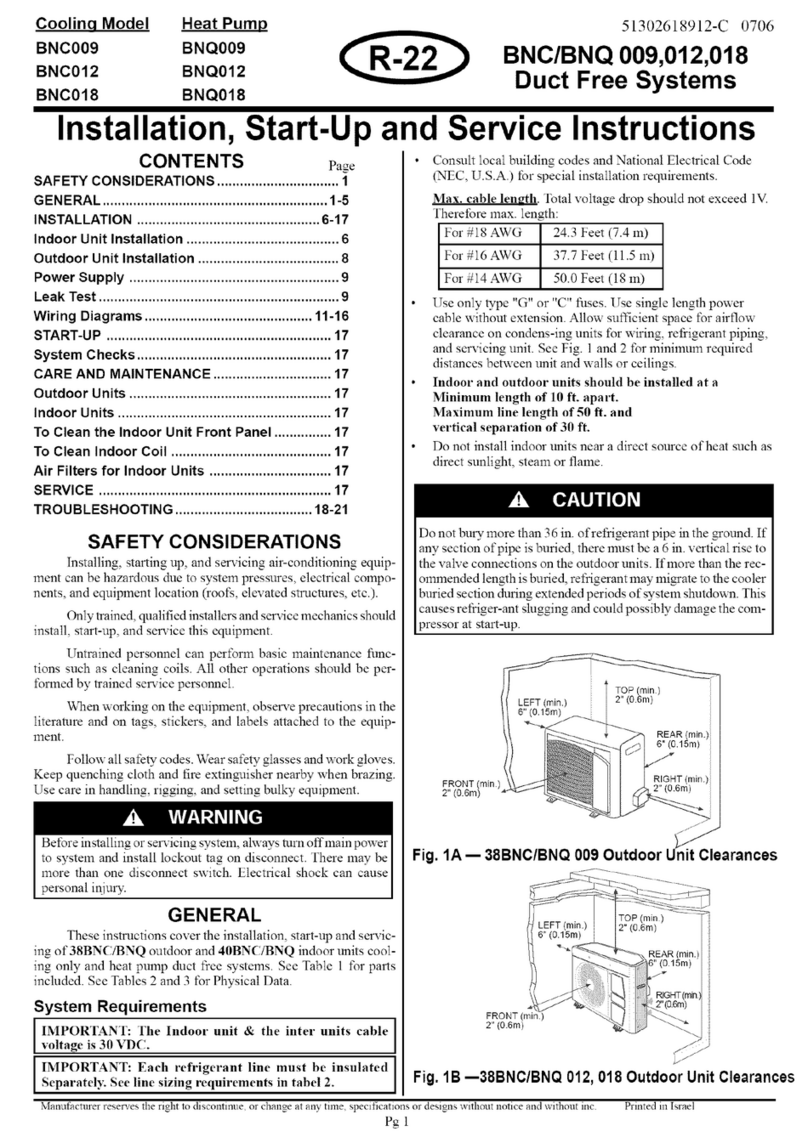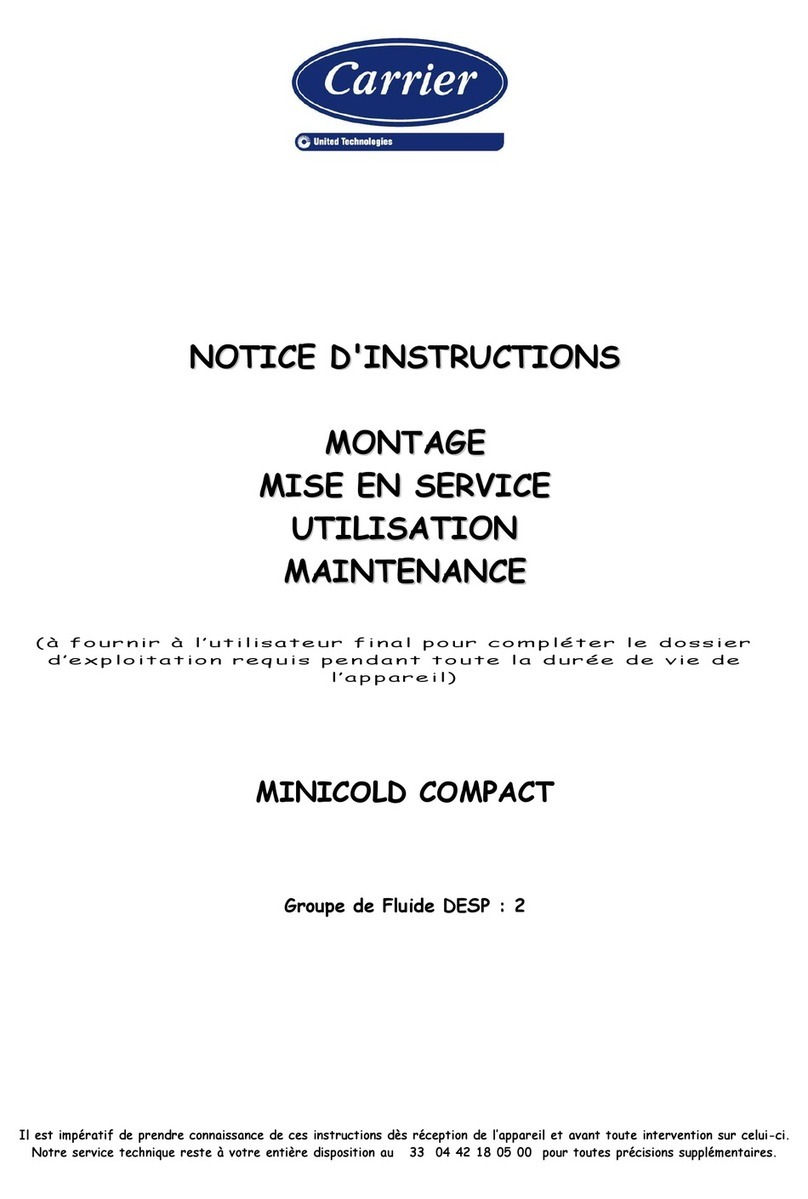
1 - INTRODUCTION
Prior to the initial start-up of the 30RQM/30RQP units, everyone
involved in the works should be thoroughly familiar with these
instructions and with the characteristics of the installation site, and
ensure these are respected.
30RQM/30RQP heat pumps are designed to provide a very high
level of safety and reliability, making installation, start-up, operation
and maintenance easier and safer.
They will provide safe and reliable service if used within their
application ranges.
They are designed to offer a service life of 15 years, assuming a
utilisation factor of 75%, which corresponds to approximately
100,000 operating hours.
The procedures in this manual are arranged in the sequence
required for installation, start-up, operation and maintenance of
the units. Ensure that you follow all the required safety precautions,
including those listed in this guide, such as: wearing personal
protective equipment (gloves, safety glasses, safety shoes), having
the appropriate tools, skills and qualications (electrical, air
conditioning, local legislation).
To find out whether these products comply with European
directives (machine safety, low voltage, electromagnetic
compatibility, pressure equipment, etc.) check the declarations of
conformity for these products.
1.1 - Specic features of 30RQP units
The 30RQP units differ from the 30RQM units by introducing
variable speed drives on all of the fans and optimising the overall
energy efciency of the unit depending on the operating conditions
(air temperature, circuit capacity). This improves the seasonal
efciency (SCOP and ESEER).
All fans in the same refrigerant circuit are controlled by a single
variable speed drive. Therefore, they operate together at the same
rotational speed. The rotational speed of each circuit is controlled
by an algorithm that continuously optimises the condensing
temperature in cooling mode or the evaporating temperature in
heating mode. This ensures optimal energy efciency of the units
(EER and COP) whatever the operating conditions.
1.2 - Installation safety considerations
After the unit has been received, and before it is started up, it must
be visually inspected for damage. Check that the refrigerant circuits
are intact, taking care to check that no components or pipes have
shifted or been damaged (following an impact, for example). If in
doubt, carry out a leak tightness check. If damage is detected
upon receipt, le a claim with the shipping company immediately.
Do not remove the skid or the packaging until the unit is in
its nal position.
These units can be safely moved with a fork lift truck, as long
as the forks are positioned in the location and direction shown
on the unit.
The units can also be lifted with slings, using only the
designated lifting points marked on the unit (labels on the
chassis and label with the unit handling instructions, attached
to the unit).
Use slings with the correct capacity, and follow the lifting
instructions given on the certied drawings for the unit.
Safety can only be guaranteed if these instructions are
carefully followed. Failure to do so may result in damage to
the equipment and physical injury.
DO NOT OBSTRUCT THE PROTECTIVE DEVICES.
This applies to any valves tted on the refrigerant or heat
transfer uid circuits. Check whether the original protection
plugs are still present at the valve outlets. These plugs are
generally made of plastic and must be removed before
operation. If they are still present, please remove them. Fit
devices at the valve or drain piping outlets to prevent the
penetration of foreign bodies (dust, building debris, etc.) and
atmospheric agents (water can form rust or ice). These
devices, as well as the drain piping, must not impair operation
and must not lead to a pressure drop that is higher than 10%
of the control pressure.
Classication and control:
In accordance with the Pressure Equipment Directive and
national usage monitoring regulations in the European Union,
the protective devices tted to these machines are classied
as follows:
Safety
accessory(1)
Accessory for limitation of
damage in the event of an
external re(2)
Refrigerant Side
High pressure switch X
External relief valve(3) X
Rupture disk X
Fuse plug X
Heat transfer uid side
External relief valve (4) (4)
(1) Classied for protection in normal service situations.
(2) Classied for protection in abnormal service situations. These accessories are
sized for res with a thermal ow of 10kW/m2. No combustible matter should
be placed within 6.5 m of the unit.
(3) The instantaneous over-pressure limitation of 10% of the operating pressure
does not apply to this abnormal service situation.
The control pressure can be higher than the service pressure. In this case, either
the design temperature or the high-pressure switch ensures that the service
pressure is not exceeded in normal service situations.
(4) The selection of these relief valves must be made by the personnel responsible
for completing the hydraulic installation.
Do not remove these valves under any circumstances, even
if the re risk is under control for a particular system. There
is no guarantee that the accessories have been re-installed
if the system is changed or for transport with a gas charge.
When the unit is subjected to re, a safety device prevents
rupture due to over-pressure by releasing the refrigerant. The
uid can then break down into toxic residues when in contact
with ames:
• Stay away from the unit;
• Ensure the personnel in charge of extinguishing the
re are duly warned and issued with recommendations;
• Fire extinguishers appropriate to the system and the
refrigerant type must be easily accessible.
All factory-installed relief valves are lead-sealed to prevent
any calibration change.
The external relief valves must always be piped to a safe,
external location if the units are installed in a enclosed space.
Refer to the installation regulations, for example those of
European standard EN 378 and EN 13136. Discharge ductwork
must be installed in a way that ensures that people and
property are not exposed to vented refrigerant. As the uids
can be diffused in the air, ensure that refrigerant is discharged
away from building air intakes or that it is discharged into a
sufcient quantity of suitable absorbent material. Relief
valves must be checked periodically (See the paragraph on
“Maintenance safety considerations”).
If the relief valves are installed on a change-over valve, this
is equipped with a relief valve on each of the two outlets.
Only one of the two relief valves is in operation, the other one
is isolated. Never leave the change-over valve in the
intermediate position, i.e. with both ways open (Bring the
actuator in abutment, front or back according to the outlet to
isolate). If a relief valve is removed for checking or
replacement please ensure that there is always an active relief
valve on each of the change-over valves installed in the unit.
Provide a drain in the discharge duct, close to each valve, to
avoid an accumulation of condensate or rain water. All
precautions concerning handling of refrigerant must be
observed in accordance with local regulations.
4







































